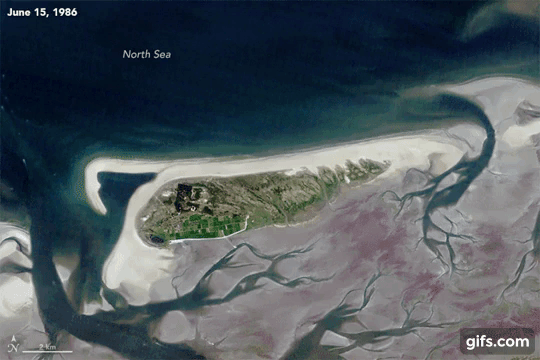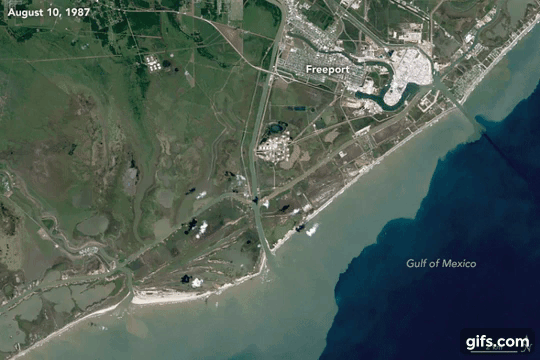A new study showed that over the past three decades, sandy beaches in the world have grown slightly in size. But researchers also observe an alarming trend in protected marine areas.
A group of researchers from the Netherlands used a special system to accurately identify sandy beaches on satellite imagery. They “taught” their image classification software to automatically determine whether the beaches are sandy, rocky or icy, and then analyze how the sandy beaches changed between 1984 and 2016.
Scientists have found that about 31% of the coastlines in the world are sandy. In Africa, the highest proportion of sandy beaches (66%), and in Europe – the lowest (22%). They also found that 24% of these sandy beaches (total shoreline distance – almost 80,000 km) were blurred at a speed exceeding 0.5 meters per year. Another 28% of sandy beaches grew, while 48% remained stable. Four of the seven largest erosion hot spots in the world were located in the United States.
The pairs of images on this page show two extreme cases. Beaches in Schiermonnikoog in the Netherlands were among the fastest growing in the study, with an increase of almost 10 meters per year. The area to the south of Freeport in Texas (below) is one of the largest hot spots of erosion in the world, in the year almost 15 meters of beach is lost along a 17-kilometer stretch. These images in natural colors were obtained by thematic using the Landsat 5 and Landsat 8 satellites.
According to scientists, the process of creating an array of data on the annual state of coastlines took only about two months of estimated time. At the same time, alternative airborne survey and manual detection of coastlines takes weeks or months to analyze only a coastline longer than 80 km.
Scientists have found that beaches in Australia and Africa were more prone to erosion than growth. On the contrary, on all other continents beaches tend to grow. At the moment, researchers believe that continental differences in beach erosion largely depend on human intervention along the coast.
The next steps will be aimed at distinguishing the influence of a person from natural dynamics and trends. Human activities accelerated erosion and growth for a variety of reasons. The extraction of sand in the Mekong Delta in Vietnam led to a high rate of erosion, which could jeopardize the region’s biodiversity and the sustainability of its fishing industry.
However, in Australia, during the special project, there is sand pumping from the Tweed River to three beaches in Queensland, which expands these beaches and improves navigation at the river mouth.
Researchers were also concerned about observations of protected marine areas. About 32% of the coastline in these reserves, marine parks and zakazniks are sandy beaches. Almost 37% of these “protected” beaches are blurred at a speed exceeding 0.5 meters per year, and only about 32% of the protected beaches are growing. Since these areas should not be subjected to human intervention, it is not clear why these beaches are being reduced.
A group of researchers from the Netherlands used a special system to accurately identify sandy beaches on satellite imagery. They “taught” their image classification software to automatically determine whether the beaches are sandy, rocky or icy, and then analyze how the sandy beaches changed between 1984 and 2016.
Scientists have found that about 31% of the coastlines in the world are sandy. In Africa, the highest proportion of sandy beaches (66%), and in Europe – the lowest (22%). They also found that 24% of these sandy beaches (total shoreline distance – almost 80,000 km) were blurred at a speed exceeding 0.5 meters per year. Another 28% of sandy beaches grew, while 48% remained stable. Four of the seven largest erosion hot spots in the world were located in the United States.
The pairs of images on this page show two extreme cases. Beaches in Schiermonnikoog in the Netherlands were among the fastest growing in the study, with an increase of almost 10 meters per year. The area to the south of Freeport in Texas (below) is one of the largest hot spots of erosion in the world, in the year almost 15 meters of beach is lost along a 17-kilometer stretch. These images in natural colors were obtained by thematic using the Landsat 5 and Landsat 8 satellites.
According to scientists, the process of creating an array of data on the annual state of coastlines took only about two months of estimated time. At the same time, alternative airborne survey and manual detection of coastlines takes weeks or months to analyze only a coastline longer than 80 km.
Scientists have found that beaches in Australia and Africa were more prone to erosion than growth. On the contrary, on all other continents beaches tend to grow. At the moment, researchers believe that continental differences in beach erosion largely depend on human intervention along the coast.
The next steps will be aimed at distinguishing the influence of a person from natural dynamics and trends. Human activities accelerated erosion and growth for a variety of reasons. The extraction of sand in the Mekong Delta in Vietnam led to a high rate of erosion, which could jeopardize the region’s biodiversity and the sustainability of its fishing industry.
However, in Australia, during the special project, there is sand pumping from the Tweed River to three beaches in Queensland, which expands these beaches and improves navigation at the river mouth.
Researchers were also concerned about observations of protected marine areas. About 32% of the coastline in these reserves, marine parks and zakazniks are sandy beaches. Almost 37% of these “protected” beaches are blurred at a speed exceeding 0.5 meters per year, and only about 32% of the protected beaches are growing. Since these areas should not be subjected to human intervention, it is not clear why these beaches are being reduced.
Tags
Natural catastrophe


